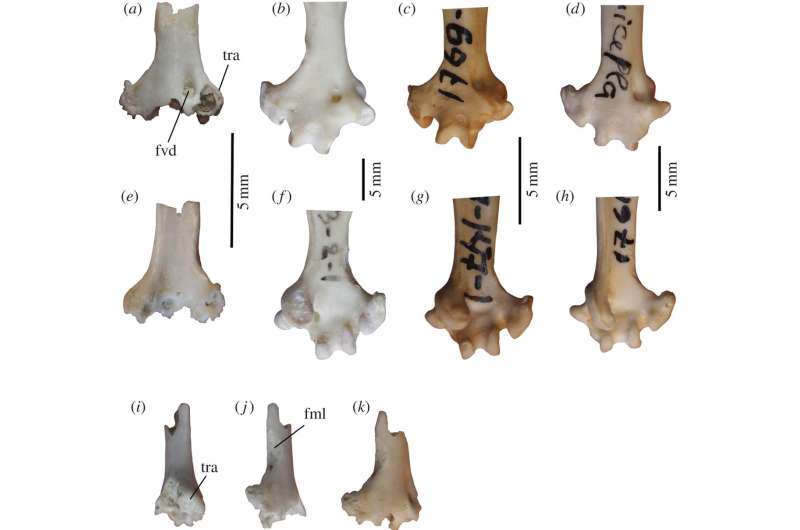October 26, 2016 report
Ancient parrot fossil found in Siberia

(Phys.org)—A Russian paleontologist has discovered a parrot fossil uncovered in Siberia several years ago—the first evidence of parrots living in Asia. In his paper published in Biology Letters, Nikita Zelenkov describes noticing the leg bone of a bird sitting in a box in his office recently, and immediately recognized that it was from a parrot.
The fossil was part of a large group of ancient animal bones dug from a site on the island of Baikal Lake at Tagay Bay in Siberia starting back in 2010—it has been dated to approximately 16 to 18 million years ago, putting it in the latter part of the Early Miocene. It has been identified as one of the bones that connects a parrots' ankle and toes, which is called a tarsometatarsus.
Most modern parrots live in tropical or sub-tropical areas, and it is quite surprising to find the remains of a parrot in an area that is bitterly cold for much of the year. But, Zelenkov notes, during the Early Miocene, the area was warmer. Also, there are some parrots that are known to live today in colder climates—one species lives in a part of the Himalayas, for example. He suggests that because the bone is so similar to the same bone in modern species, it is likely they looked similar.
Finding the fossil in Siberia suggests that theories regarding how parrots came to live in North America might have to be revised—previously, ornithologists believed they came via the Berengia land bridge that once joined North America and Asia—now, it appears just as likely that they came across the Bering Strait.
Because the fossil is so small, it is not possible to learn much else about the bird, Zelenkov notes. And because testing of it has been exhausted, study of the bone will cease, at least for now. But now that it is known that parrots lived in the area, future excavations will no doubt focus on finding parrot bones among the many others that are found.
More information: The first fossil parrot (Aves, Psittaciformes) from Siberia and its implications for the historical biogeography of Psittaciformes, Biology Letters, Published 25 October 2016.DOI: 10.1098/rsbl.2016.0717
Abstract
Modern parrots (crown Psittaciformes) are a species-rich group of mostly tropical and subtropical birds with a very limited fossil record. A partial tarsometatarsus from the late Early Miocene of Siberia (Baikal Lake) is the first pre-Quaternary find of crown Psittaciformes in Asia (and Siberia in particular) and is also the northern-most find of this bird order worldwide. This find documents a broad geographical distribution of parrots during the warmest phase of the Miocene (the so-called 'Miocene Climatic Optimum'), which has implications for the historical biogeography of Psittaciformes. The presence of parrots on both sides of the Pacific Ocean at the end of the Early Miocene implies a (most probably eastwards) trans-Beringian dispersal which likely took place about 16–18 Ma. The broad Eurasian distribution of parrots in the past further supports a hypothesis that ancestors of modern genera Coracopsis and Agapornis could reach Africa from Eurasia.
Journal information: Biology Letters
© 2016 Phys.org





















